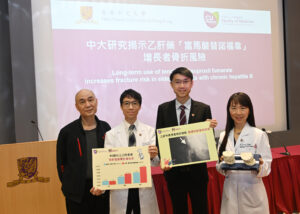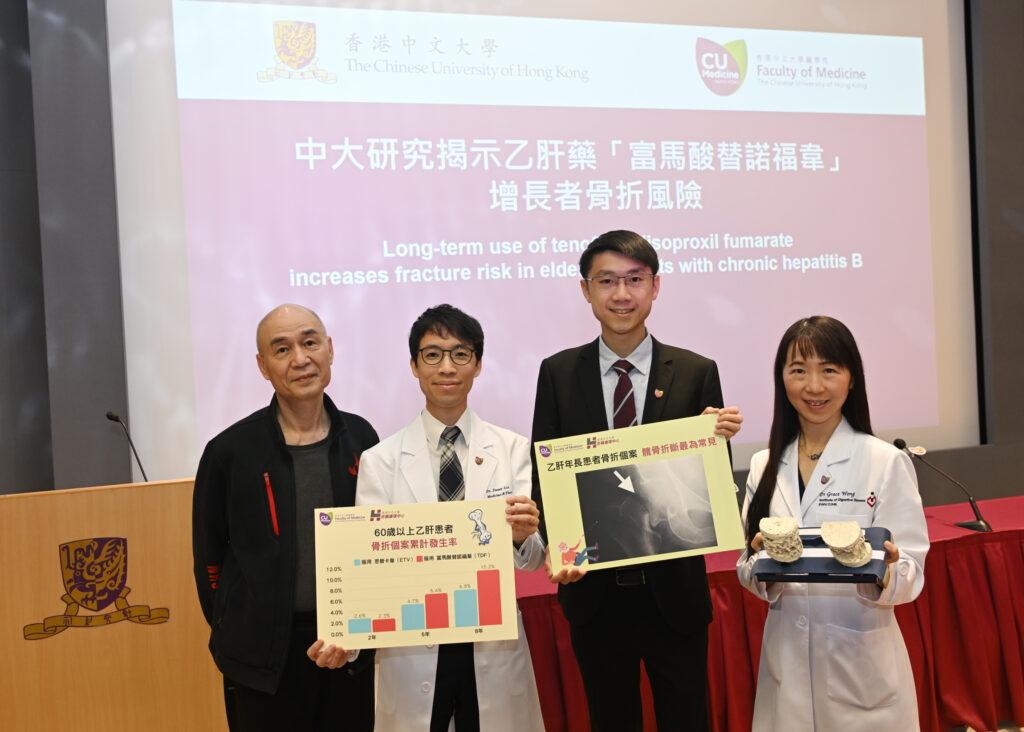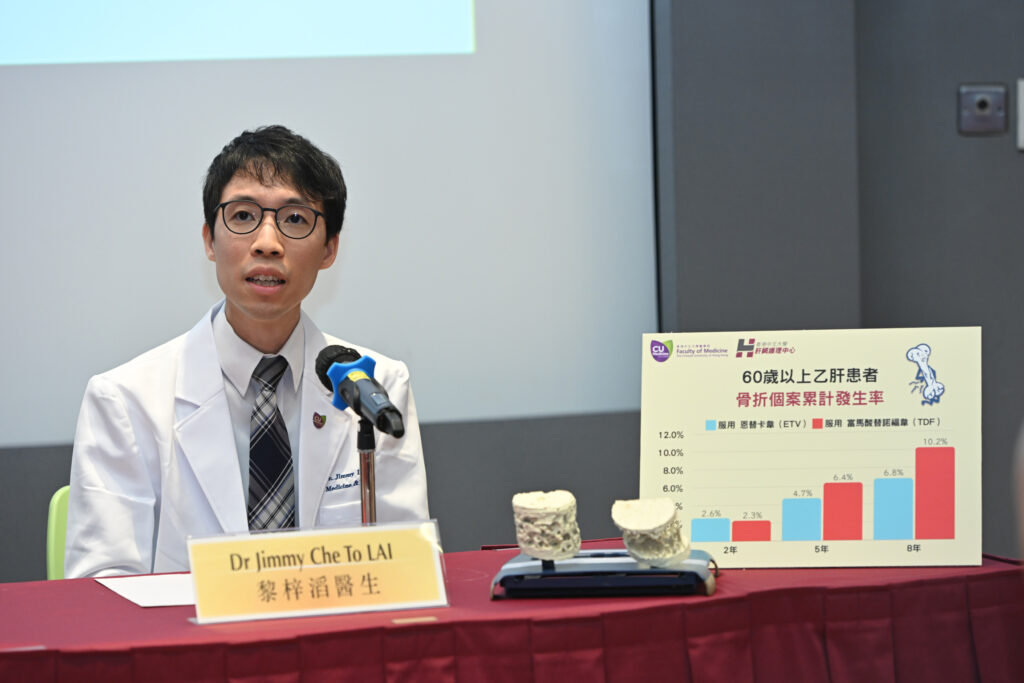CUHK
News Centre
CUHK study reveals antiviral drug tenofovir disoproxil fumarate increases fracture risk in elderly patients with chronic hepatitis B
A latest study by The Chinese University of Hong Kong (CUHK)’s Faculty of Medicine (CU Medicine) analysed data from over 40,000 patients with chronic hepatitis B aged 60 or above, comparing the long-term fracture risk associated with two common antiviral treatments, entecavir (ETV) and tenofovir disoproxil fumarate (TDF), in Hong Kong. Results showed TDF is associated in those patients with a higher fracture risk than ETV after two years of treatment. Researchers reminded doctors to take other health conditions into consideration when prescribing antiviral treatments to patients with chronic hepatitis B and provided some suggestions on fracture prevention. Details of the study have been published in the Journal of Hepatology, an international medical journal.
Antiviral drug TDF is associated with a decrease in bone mineral density
Chronic hepatitis B is a liver disease caused by hepatitis B virus (HBV) infection. According to the Population Health Survey 2020-22, about 6.2% of the Hong Kong population, or about 465,000 people, is infected with HBV. Antiviral medication is effective in inhibiting HBV replication and reducing the risk of cirrhosis, liver failure and liver cancer. ETV and TDF are the two most common first-line antiviral hepatitis B drugs used locally.
Professor Grace Wong Lai-hung from the Department of Medicine and Therapeutics, CU Medicine, Director of the Medical Data Analytics Centre (MDAC) and Deputy Director of CUHK Center for Liver Health, said, “Some patients with chronic hepatitis B have to undergo long-term or even lifelong antiviral treatment, so it is crucial to learn the medication’s health burden on them in the long run. Though TDF is an effective treatment, it is known to be associated with a decrease in bone mineral density. Elderly people are prone to fractures when they fall or are hit if their bone density is low. We therefore launched this study to look for scientific evidence of the association and to generate more comprehensive clinical guidance for patients in managing the disease.”
An all-round review of health conditions is suggested before prescribing antiviral drugs to elderly patients
The CU Medicine research team, led by Dr Terry Yip Cheuk-fung and Dr Jimmy Lai Che-to, used data from the Hospital Authority’s electronic healthcare database Clinical Data Analysis and Reporting System (CDARS) to analyse and compare the fracture risk of 41,531 patients with chronic hepatitis B aged 60 or above who were taking ETV or TDF medication between 2008 and 2022. The research team reviewed the progression of their health condition for eight years after they started treatment. Results showed the TDF group had a higher fracture risk after two years of treatment compared to the ETV group. (Please refer to Appendix 1 for more detailed data.)
Dr Terry Yip Cheuk-fung, Assistant Professor in the Department of Medicine and Therapeutics, CU Medicine and Deputy Director of MDAC, said, “Our analysis showed ETV-treated patients and TDF-treated patients had a comparable cumulative incidence of incident fracture in the first two years of treatment, but an increased risk of incident fracture was observed in the TDF group after month 24. The cumulative incidence among the TDF group in the eighth year was 50% higher than that of the ETV group. We can therefore conclude that TDF is associated with a higher fracture risk after two years of usage in patients aged 60 or above, and this also applies to patients aged 70 or above.”
Dr Jimmy Lai Che-to, Specialist in Gastroenterology and Hepatology, Department of Medicine and Therapeutics, Prince of Wales Hospital and Clinician Clinical Lecturer (honorary), Department of Medicine and Therapeutics, CU Medicine, added, “Based on the findings, we suggest an all-round review of health condition before prescribing antiviral treatment for elderly patients with hepatitis B. Previous literature pointed out that patients with incident fractures are more likely to have diabetes, hypertension, osteoporosis or other comorbidities. Tenofovir alafenamide (TAF), a new generation of nucleotide analogue, could also be an alternative drug for patients with renal disease or osteoporosis.”
The research team also suggested patients with hepatitis B adopt a healthy lifestyle to lower the risk of fracture, such as adequate intake of vitamin D, calcium and protein, quitting smoking, and exercising regularly. (Please refer to Appendix 2 for more detailed data.)

A latest study CU Medicine shows antiviral tenofovir disoproxil fumarate (TDF) is associated with a higher fracture risk than entecavir (ETV) for patients with chronic hepatitis B aged 60 or above, after two years of treatment. Researchers remind doctors to take other health conditions into consideration when prescribing antiviral treatments to patients with chronic hepatitis B.
(From left) Mr Lei, patient with chronic hepatitis B; Dr Jimmy Lai Che-to, Specialist in Gastroenterology and Hepatology, Department of Medicine and Therapeutics, Prince of Wales Hospital and Clinician Clinical Lecturer (honorary), Department of Medicine and Therapeutics, CU Medicine; Dr Terry Yip Cheuk-fung, Assistant Professor in the Department of Medicine and Therapeutics, CU Medicine and Deputy Director of MDAC; and Professor Grace Wong Lai-hung, Professor in the Department of Medicine and Therapeutics, CU Medicine; Director of the Medical Data Analytics Centre (MDAC) and Deputy Director of CUHK Center for Liver Health.

Dr Terry Yip says an increased risk of incident fracture was observed in the TDF group after month 24. The cumulative incidence among the TDF group in the eighth year was 50% higher than that of the ETV group.

Professor Grace Wong suggests elderly patients with chronic Hepatitis B should be aware of osteoporosis risk and conduct a bone density test if necessary.










